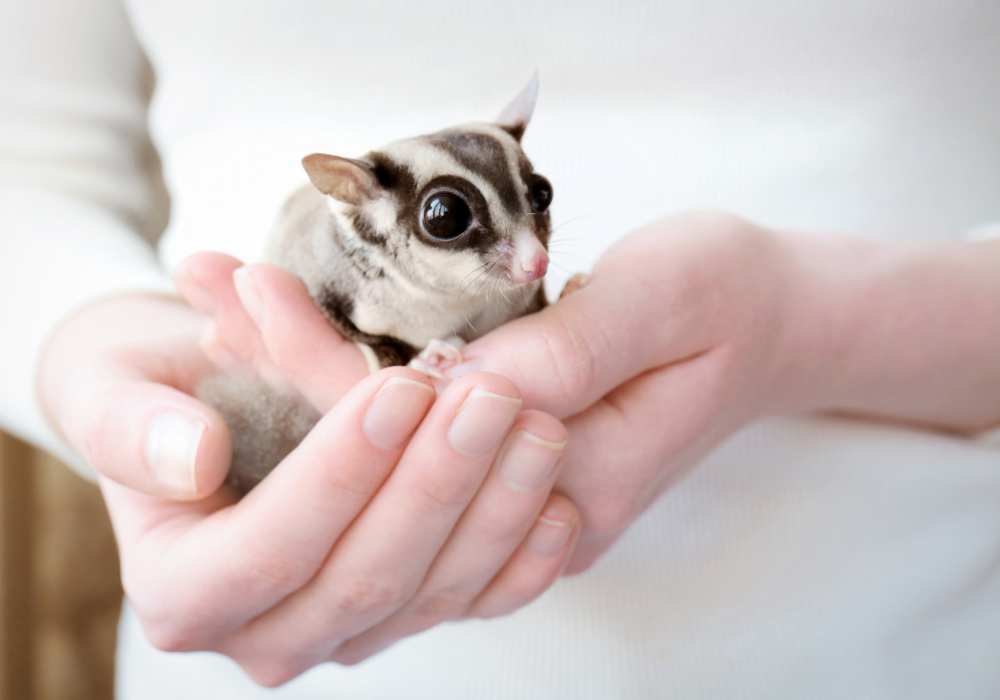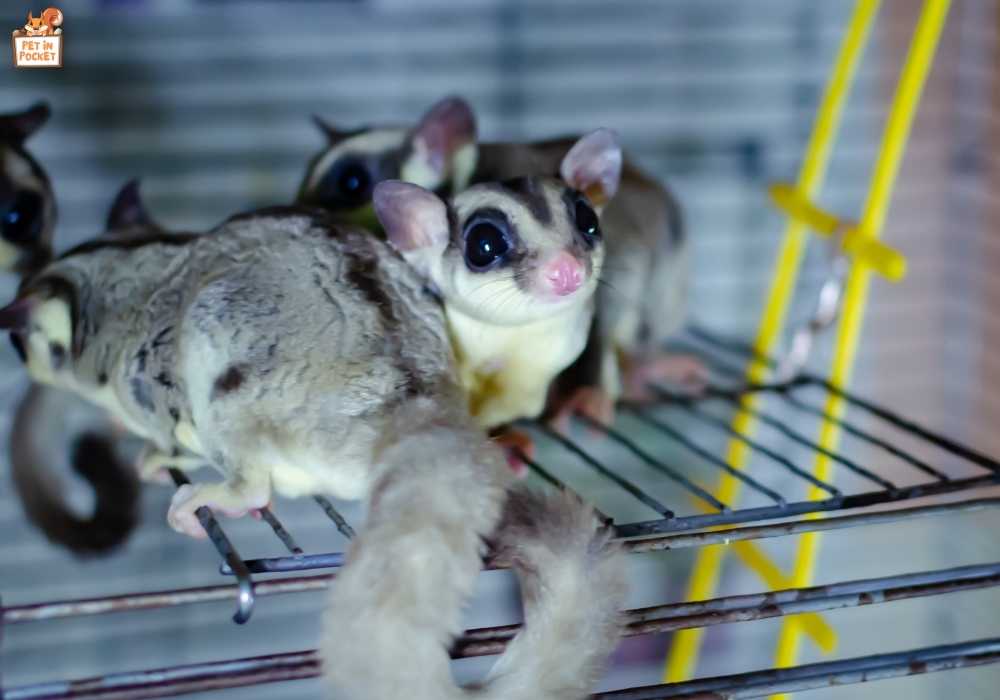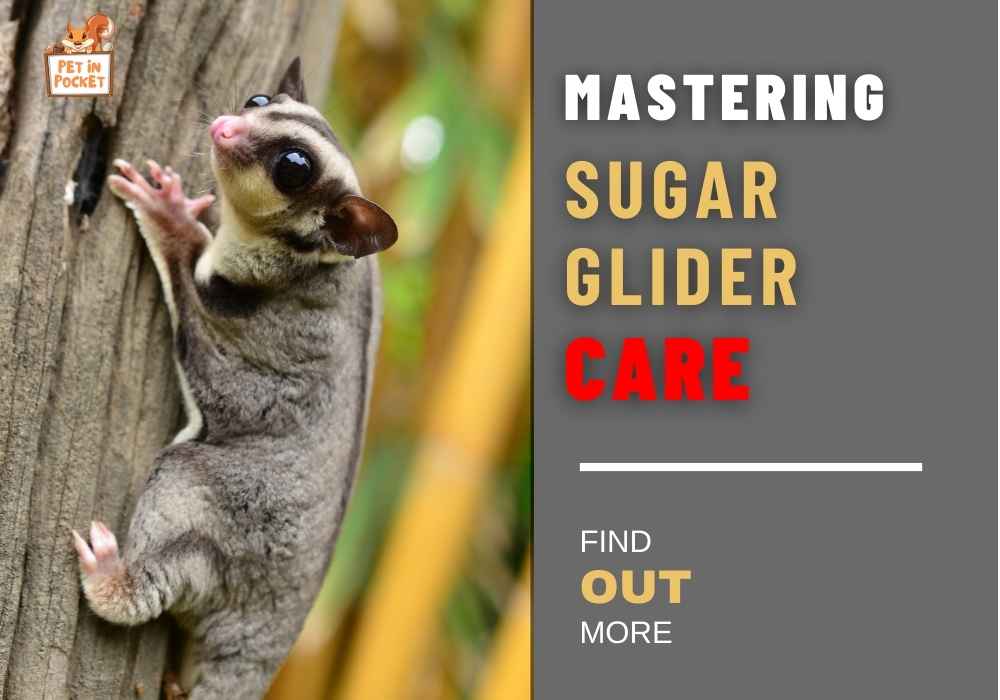Welcome to the fascinating world of sugar gliders! These small, adorable marsupials have become increasingly popular as pets in recent years, and with good reason. With their unique appearance, charming personalities, and lively nature, sugar gliders make wonderful companions for those willing to learn how to properly care for them. In this virtual discussion, we will delve into the essentials of sugar glider care, from understanding their needs and behavior to creating a comfortable habitat for them.
Whether you are a new sugar glider owner or considering bringing one into your home, this guide will provide you with valuable tips and tricks to ensure the well-being and happiness of your sugar glider friend. So, let’s jump right in and embark on this exciting journey of mastering sugar glider care!
Table of Contents
Understanding Your Sugar Glider’s Needs
To provide your sugar glider with the best possible environment, it is important to understand their unique needs. By taking the time to learn about their behavior and communication, you can establish a deep bond and cultivate a fulfilling relationship with your adorable glider. Embrace their cute faces, gliding abilities, and captivating behaviors as you master the art of sugar glider care.
Recognizing Sugar Glider Behavior and Communication
To understand your sugar glider’s needs, it’s essential to recognize their behavior and communication cues through various visual, vocal, and scent-based signals. By observing their body language, you can determine whether they are comfortable, stressed, or seeking attention. Additionally, decoding their vocalizations, such as barks, chatters, and purring sounds, serves a specific purpose in communication. Barking can indicate a warning or distress, while chattering often indicates contentment and bonding. Sugar gliders also communicate through scent marking, rubbing their chest and forehead against objects to mark their territory and communicate with other gliders. Understanding your sugar glider’s behavior and communication will help you provide the best possible care.
Decoding Sugar Glider Sounds
Understanding Vocalizations
Decoding the vocalizations of sugar gliders is key to understanding their moods and needs. By learning to differentiate between various sounds, you can better respond to their desires and create a harmonious bond.
Sugar gliders make different sounds, ranging from chirping, barking, and hissing, to soft purring noises. Each sound has a distinct meaning, and being able to interpret these sounds will allow you to provide the appropriate care and attention.
For example, alarm calls indicate a potential threat, and it’s essential to investigate and ensure their safety. On the other hand, soft purring noises are often associated with relaxation and contentment. By recognizing and responding to these vocalizations, you can provide the right environment for your sugar glider’s well-being.
Are sugar gliders hard to take care of?

Sugar gliders are unique pets that can be well-suited for domestic life with proper care. They may appear exotic, but with knowledge and commitment, they can live comfortably. Although they need special attention, taking care of them is not too challenging.
The cost and time commitment of owning a sugar glider
Cost and Time Commitment
Owning a sugar glider entails both financial and time commitments. Before deciding to bring one into your home, it’s important to be aware of the costs and responsibilities involved. Here are some key factors to consider:
- Budget for initial setup costs, including a suitable cage, toys, and food.
- Ongoing expenses, such as veterinary care, food supplies, and enrichment items.
- Dedicate time daily for feeding, cleaning, and interactive play with your sugar glider.
- Understand that sugar gliders have a relatively long lifespan, meaning a commitment of 12 to 15 years or more.
- Be prepared for unexpected medical costs or emergencies that may arise.
Necessary supplies and equipment for proper care
Essential Supplies for Sugar Gliders
To ensure the well-being and happiness of your sugar glider, it is important to have the necessary supplies and equipment in place. Here are some essential items you will need:
- A spacious and secure cage with platforms, ladders, and climbing opportunities.
- A nutritionally balanced diet consisting of fresh fruits, vegetables, protein, and occasional treats.
- Bonding and sleeping pouches to simulate their natural environment and provide security.
- A safe exercise wheel and climbing branches for physical activity and mental stimulation.
- A first aid kit with basic supplies to address minor injuries or health issues.
Social needs and bonding with your sugar glider
Fostering a Strong Bond
Sugar gliders are highly social animals and thrive on companionship and interaction. Building a strong bond with your sugar glider not only enhances their well-being but also enriches your own experience as a pet owner. Here are some tips for fostering a strong bond with your sugar glider:
- Spend quality time bonding with your sugar glider through gentle handling, play, and positive interactions.
- Establish trust by offering treats, speaking softly, and avoiding sudden movements or loud noises.
- Respect their boundaries and cues, allowing them to initiate contact and interaction at their own pace.
- Create a consistent routine, as sugar gliders appreciate predictability and will feel more secure.
- Involve other family members in caring for and interacting with your sugar glider, reinforcing the sense of a social group.
Setting Up a Comfortable Habitat
Creating a cozy abode for your sugar glider is key to their well-being. Pick a spacious cage to allow ample room for movement and play. Ensure the cage stays clean through regular maintenance, promoting a healthy environment. Enrich their space with essential accessories like branches, hammocks, and toys for mental stimulation. Remember, a comfortable habitat is vital for your sugar glider’s physical and mental health.
Choosing the Right Cage Size and Material

When setting up your sugar glider’s habitat, ensure the cage provides ample space for movement and exploration. Opt for wire cages that allow climbing and proper ventilation. Remember to check that the bar spacing is narrow enough to prevent any escape attempts. Choose materials that are easy to clean to maintain proper hygiene levels.
Lastly, provide a solid base within the cage to prevent any potential injuries from wire flooring. Your sugar glider will thrive in a well-suited environment.
Essential Cage Accessories for Sugar Gliders
When setting up your sugar glider’s habitat, it’s essential to provide a variety of cage accessories. Include cozy hammocks for resting and sleeping, a wheel for exercise and entertainment, branches and ropes for climbing, pouches for nesting and bonding, and strategically placed feeding stations for easy access to food. These accessories cater to your sugar glider’s natural behaviors and promote a happy and healthy environment within the cage. Enhance your sugar glider’s living space with these essential items to ensure their well-being and enrichment.
Maintaining Cage Cleanliness
To maintain a hygienic environment for your sugar glider, it’s vital that you promptly dispose of waste and soiled bedding. Make sure to clean food and water containers daily, as well as wash toys and accessories weekly to help maintain cleanliness. It’s crucial to disinfect the cage monthly to prevent bacterial growth. Keep an eye out for any indications of mold or pests within the enclosure.
Health Concerns and Veterinary Care
To master sugar glider care, it’s crucial to understand their health needs. Regular vet checkups are an essential aspect of ensuring their well-being and detecting any health issues early on. It’s essential to become familiar with common health concerns that sugar gliders face, such as nutrient deficiencies or dental problems. In case of emergencies, it’s vital to know where to seek immediate veterinary care to guarantee the best outcome for your beloved pocket pet. By staying proactive and taking care of your sugar glider’s health, you can foster a long and happy companionship.
Common Health Issues in Sugar Gliders
To ensure the best health for your sugar glider, it is crucial to keep an eye out for signs of nutritional deficiencies. Address dental issues such as overgrowth immediately and attend to any injuries to prevent complications. Regularly monitor for parasitic infections and recognize stress-related symptoms, as these are paramount for sugar glider health. Staying alert and proactive in your sugar glider’s care will help them thrive.
Routine Vet Checkups for Sugar Gliders
As a sugar glider owner, it’s important to prioritize routine vet checkups for your furry friend. Schedule annual wellness exams for preventive care and discuss vaccination options with your vet. Regularly conduct fecal tests to check for internal parasites and seek guidance on the most appropriate diet and supplements for your pet. During your visits to the vet, make sure to address any concerns or behavioral changes in an active and affirmative manner. Being proactive with veterinary care is essential for ensuring the health and well-being of your sugar glider.
Emergency Care for Sugar Gliders
In case of any emergencies involving your sugar glider, it is vital to be well-prepared with a stocked first aid kit. Knowing the nearest exotic animal veterinarian who has experience in treating sugar gliders is crucial for prompt care. Understanding common health issues that may affect sugar gliders can help you recognize symptoms early. Regularly monitoring your sugar glider’s behavior for any signs of distress or illness enables proactive intervention if needed. Quick action is essential upon noticing any unusual symptoms in your beloved pet.
Training Your Sugar Glider
Training your sugar glider involves bonding through effective training techniques. Understanding your pet’s behavior is key to successful training. Patience and consistency are crucial for building a strong bond with your sugar glider. Using positive reinforcement methods like treats can help in training. Socialization and interaction play a significant role in the training process, enhancing the relationship between you and your sugar glider. Strengthen your connection with your pet by spending quality time together.
Effective Training Techniques for Sugar Gliders
When training your sugar glider, you can effectively link positive behavior with the sound of a clicker. By consistently repeating tricks and commands, and rewarding your glider, you can successfully train them. It’s important to maintain a calm tone during training sessions to minimize stress and handle your glider gently to foster trust. Incorporating playtime is also essential to keep training engaging for your sugar glider.
Bonding with Your Sugar Glider
To foster a strong bond with your sugar glider, devote daily quality time for bonding. Utilize a bonding pouch to carry your glider close to you. Strengthen your connection by offering treats and engaging in interactive play sessions. Respect your pet’s boundaries and allow them to initiate contact when comfortable.
Sugar Glider Legalities and Ethical Concerns
Compliance with regulations related to exotic pet ownership, especially those concerning wildlife protection laws, is crucial for responsible sugar glider ownership. Equally important is understanding the ethical considerations of keeping these unique animals as pets and adhering to guidelines that ensure their well-being and conservation. As a caring sugar glider owner, staying informed and acting conscientiously are key pillars in navigating matters of legality and ethics.
Understanding Legal Restrictions on Sugar Glider Ownership
When owning a sugar glider, it’s crucial to adhere to local laws and regulations. Acquiring the necessary permits or licenses is essential for legal compliance. Staying updated on any legislative changes affecting sugar glider ownership is vital. Seeking advice from animal welfare groups can provide valuable insights into legal obligations. Respecting and following restrictions are key to safeguarding sugar gliders and their environment.
Is it Ethical to Keep a Sugar Glider as a Pet?
Consider the well-being of your sugar glider when deciding on pet ownership. Understand their natural behaviors and social needs, providing a stimulating environment akin to their habitat. Seek advice from experts for ethical care practices, prioritizing the sugar glider’s welfare above all.
How to tell if my sugar glider is dying

Signs of distress in sugar gliders can include changes in behavior, decreased appetite, and lethargy. Keep an eye out for any unusual vocalizations or difficulties in movement. If you notice these signs, prompt action is necessary in contacting a vet who specializes in exotic pets. Monitoring your sugar glider’s health regularly, especially in February, can help in early detection of any health issues. Utilize social media platforms like Facebook to connect with other sugar glider owners for support and advice.
Signs of illness in sugar gliders
It is crucial to be attentive to signs of illness in sugar gliders. Red flags to look out for include weight loss, lethargy or loss of appetite. Behavioral shifts such as aggression, excessive grooming, or increased hiding may indicate health issues.
Keep an eye on physical indications like eye, nose or ear discharges. By monitoring your sugar glider’s droppings for any irregularities in color or consistency, you can also provide valuable health insights. If you notice any concerning or persistent symptoms, seeking professional advice is imperative. Remember to stay vigilant in observing your sugar glider’s health and well-being.
Common causes of death in sugar gliders
Understanding the risks of poor nutrition is crucial for sugar gliders’ well-being. Falls and injuries can have devastating consequences on their health. Toxic substances pose a serious threat, so vigilance is key. Additionally, loneliness and neglect can impact their longevity. To ensure a safe environment, proactively address stressors and create a nurturing space for your sugar glider.
Steps to take if you suspect your sugar glider is dying
Preventative measures for maintaining the health of your sugar glider
To maintain your sugar glider’s well-being, offer a varied diet rich in fruits, vegetables, and protein. Regularly clean its habitat to ensure hygiene. Schedule routine vet visits for preventive care. Create a safe space to prevent accidents. Watch for any behavioral changes that could signal health issues. By following these measures, you can promote the health and happiness of your beloved pet.
Conclusion
Taking care of a sugar glider requires understanding their unique needs and providing a comfortable habitat. It’s important to recognize their behavior and communication cues, as well as invest time and effort into training and bonding. Regular veterinary checkups are crucial for maintaining their health, and being aware of common health issues and emergency care is essential.
Additionally, it’s important to be aware of the legal restrictions and ethical concerns surrounding sugar glider ownership. By following these tips and tricks, you can become a master in sugar glider care and ensure the well-being of your adorable pet.
Remember to always prioritize their health and happiness, and enjoy the wonderful journey of being a sugar glider parent!
Frequently Asked Questions
What is the best diet for a sugar glider?
A balanced diet for a sugar glider includes a combination of fresh fruits and vegetables, high-quality protein sources, and a commercial pellet feed formulated for sugar gliders. Avoid feeding them processed foods and high-sugar content treats.
Can sugar gliders be trained?
Yes, sugar gliders can be trained to do tricks and respond to commands. Consistency, patience, and positive reinforcement are key to successful training.
How often should I take my sugar glider to the vet?
It’s recommended to take your sugar glider to the vet at least once a year for a check-up. However, if you notice any changes in behavior or health issues, take them to the vet immediately.
Do sugar gliders need a companion?
Sugar gliders are social animals and thrive in pairs or groups. It’s recommended to have at least two sugar gliders to keep each other company and prevent loneliness.
Are sugar gliders legal to own as pets?
The legality of owning a sugar glider as a pet varies by state and country. Always research and abide by local laws and regulations before getting a sugar glider.






Leave a Reply